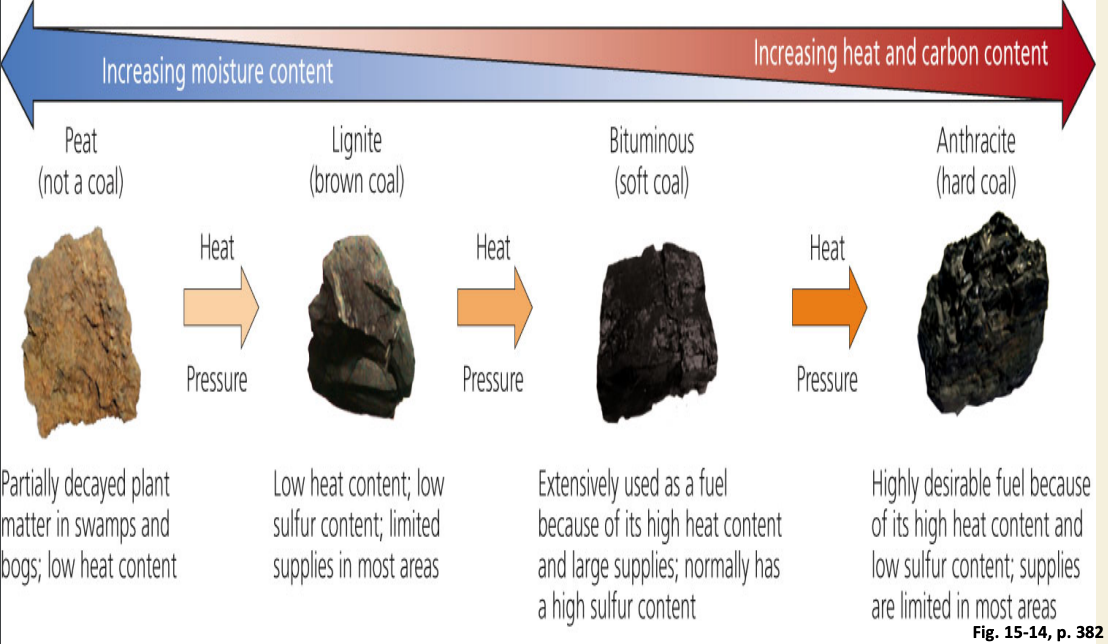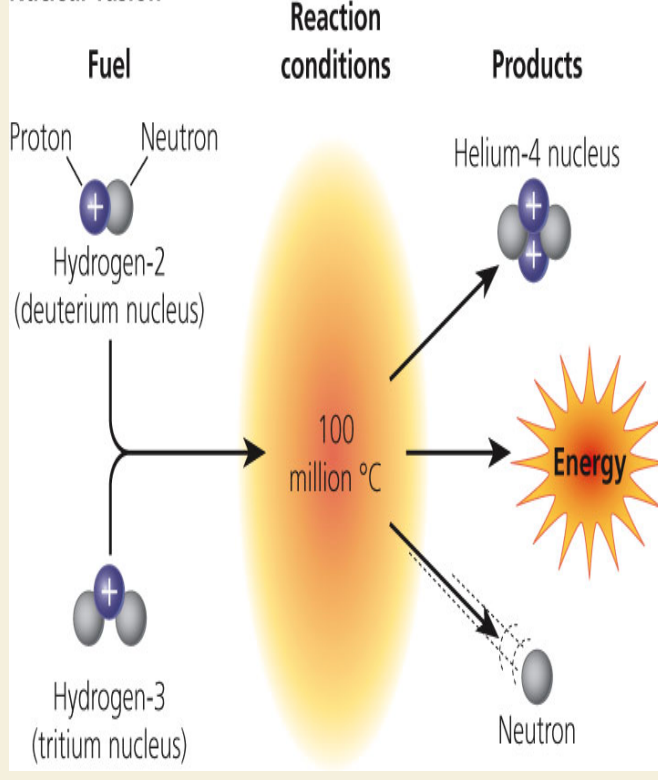Chapter 15: Nonrenewable Energy
What is Net Energy and Why Is It Important?
The Laws That Govern Energy
The first law of thermodynamics: It takes high-quality energy to get high-quality points. Pumping oil from the ground, refining it, transporting it.
The second law of thermodynamics: Some high-quality energy is wasted at every step
Basic Science: Net Energy Is the Only Energy That Really Counts
Net Energy: Total amount of useful energy available from a resource minus the energy needed to make the energy available to consumers
Business net profit: Total money taken in minus all expenses
New energy ratio: ratio of energy produced to energy used to produce it
Conventional oil
high net energy ratio
Energy Resources With Low/Negative Net Energy Yields need Marketplace Help
Cannot compete in open markets with alternatives that have higher net energy yields
Need subsidies from taxpayers
Ex. Nuclear power
Reducing Energy Waste Improves Net Energy Yields and Can Save Money
84% of all commercial energy used in the U.S. is wasted
43% after accounting for the second law of thermodynamics
Make buildings energy efficient, drive efficient cars, not gas guzzlers
What Are the Advantages and Disadvantages of Oil?
How Does Oil and Natural Gas Form?
Fracking: High-pressure pumps shoot a mixture of water, sand, and chemicals into the well; the pressure builds up and creates cracks so that the oil/natural gas can flow up to the surface
Ocean
Tiny sea plants and animals died and were buried on the ocean floor. Over time, they were covered by layers of slit and sand
Over millions of years, the remains were buried deeper and deeper. The enormous heat and pressure turned them into oil and gas.
Today, we drill down through layers of sand, silt, and rock to reach the rock formations that contain oil and gas deposits
Oil Dependence
Petroleum, or crude oil
conventional, or light oil
1/3 of the commercial world’s energy
40% of that used in the USA
Peak production: the time after which production from a good declines
Global peak production for all world oil
Refining Crude Oil
Refining: Heating crude oil to separate it into various fuels and other components with different boiling points in a complex process
Photochemical: Products of oil distillation, raw materials for industrial organic chemicals
Pesticides
Paints
Plastics
Petrochemicals: the 2% of the products of refining; used for raw materials to make industrial organic chemicals, cleaning fluids, pesticides, plastics, synthetic fibers, paints, medicines, cosmetics, ice cream, and many other productT
Oil Reserves
Proven oil reserves: Identified deposits that can be extracted profitably with current technology
Unproven reserves
Probable reserves: 50% chance of recovery
Possible reserves: 10-40% chance of recovery
Conventional Oil
Advantages
Ample supply for several decades
High net energy yield but decreasing
Low land disruption
Efficient distribution system
Disadvantages
Water pollution from oil spills and leaks
Environmental costs not included in market price
Releases CO2 and other air pollutants when burned
Vulnerable to international supply interruptions
Heavy Oils from Oil Shale and Tar Sand
Advantages
Large potential supplies
Easily transported within and between countries
The efficient distribution system in place
Disadvantages
Low net energy yield
Releases CO2 and other air pollutants when produced and burned
Severe land disruption and high water use
What Are the Advantages and Disadvantages of Using Natural Gas?
Natural Gas Is a Useful and Clean-Burning Fossil Fuel
Natural gas
a mixture of gases
50-90% is methane -- CH4
Conventional natural gas
Pipelines
Liquefied petroleum gas (LPG): When propane and butane gases are liquefied under high pressure
Liquefied natural gas (LNG): Low net energy yield and makes the U.S. dependent upon unstable countries like Russia and Iran
Is Unconventional Natural Gas the Answer?
Coal bed methane gas
In coal beds near the earth’s surface
In shale beds
High environmental impacts or extraction
Methane hydrate
Trapped in icy water
In permafrost environments
On ocean floor
Costs of extraction are currently too high
Conventional Natural Gas
Advantages
Ample supplies
High net energy yield
Emits less CO2 and other pollutants than other fossil fuels
Disadvantages
Low net energy yield for LNG
Releases CO2 and other air pollutants when burned
Difficult and costly to transport from one country to another
What Are the Advantages and Disadvantages of Coal?
Coal Is a Plentiful but Dirty Fuel
Coal: solid fossil fuel
Burned-in power plants; generates 42% of the world’s electricity
Inefficient
Three largest coal-burning countries: China, the United States, and Canada
World’s most abundant fossil fuel
The U.S. has 28% of proven reserves
Environmental costs of burning coal
Severe air pollution
Sulfur released as SO2
A large amount of soot
CO2
Trace amounts of Hg and radioactive materials

Coal
Advantages
Ample supplies in many countries
High net energy yield
Low cost when environmental costs are not included
Disadvantages
Severe land disturbance and water pollution
Fine particles and toxic mercury emissions threaten human health
Emits large amounts of CO2 and other air pollutants when produced and burned
We Can Convert Coal into Gaseous and Liquid Fuels
Conversion of solid coal to
Synthetic natural gas (SNG) by coal gasification
Methanol or synthetic gasoline by coal liquefaction
Synfuels
Synthetic Fuels
Advantages
Large potential supply in many countries
Vehicle fuel
Lower air pollution than coal
Disadvantages
Low to moderate net energy yield
Requires mining 50% more coal with increased land disturbance, water pollution, and water use
Higher CO2 emissions than coal
What Are the Advantages and Disadvantages of Nuclear Energy?
How Does a Nuclear Fission Reactor Work?
Controlled nuclear fission reaction in a reactor
Light-water reactors
Very inefficient
Fueled by uranium ore and packed as pellets in fuel rods and fuel assemblies
Control rods absorb neutrons
Water is the usual coolant
Containment shell around the core for protection
Water-filled pools or dry casks for storage of radioactive spent fuel rod assemblies
What Is the Nuclear Fuel Cycle?
Mine the uranium
Process the uranium to make the fuel
Use it in the reactor
Safely store the radioactive waste
Decommission the reactor
Conventional Nuclear Fuel Cycle
Advantages
Low environmental impact (without accidents)
It emits 1/6 as much CO2 as coal
Low risk of accidents in modern plants
Disadvantages
Very low net energy yield and high overall cost
Produces long-lived, harmful radioactive wastes
Promotes the spread of nuclear weapons
Coal vs. Nuclear
Coal
High net energy yield
Very high emissions of CO2 and other air pollutants
High land disruption from surface mining
Low cost when environmental costs are not included
Nuclear
Very low net energy yield
Low emissions of CO2 and other air pollutants
Much lower land disruption from surface mining
The high cost (even with huge subsidies)
Dealing with Radioactive Wastes Produced by Nuclear Power Is a Difficult Problem
High-level radioactive wastes
Must be stored safely for 10,000–240,000 years
Where to store it
Deep burial→safest and cheapest option
Would any method of burial last long enough?
There is still no facility
Shooting it into space is too dangerous
Can Nuclear Power Lessen Dependence on Imported Oil & Reduce Global Warming?
Nuclear power plants: no CO2 emission
Nuclear fuel cycle: emits CO2
Opposing views on nuclear power
Nuclear power advocates
2007: Oxford Research Group
Need a high rate of building new plants, plus a storage facility for radioactive wastes
Are New Generation Nuclear Reactors the Answer?
Advanced light water reactors (ALWR): Built-in passive safety features
Thorium-based reactors: Cheaper and safer but research and development are needed
Solutions: New Generation Nuclear Reactors
Reactors must be built so that a runaway chain reaction is impossible
The reactor fuel and methods of fuel enrichment and fuel reprocessing must be such that they cannot be used to make nuclear weapons
Spent fuel and dismantled structures must be easy to dispose of without burdening future generations with harmful radioactive waste
Taking its entire fuel cycle into account it must generate a net energy yield high enough so that it does not need government subsidies, tax breaks, or loan guarantees to compete in the open marketplace
Its entire fuel cycle must generate fewer greenhouse gas emissions than other energy alternatives
Will Nuclear Fusion Save Us?
Nuclear fusion: Fuse lighter elements into heavier elements, No risk of meltdown or large radioactivity release

 Knowt
Knowt
